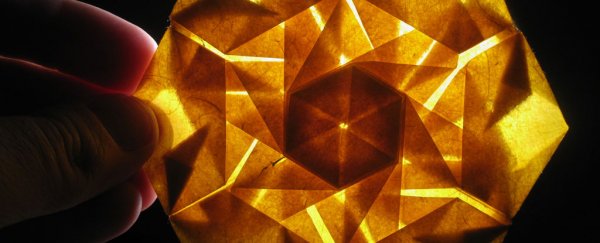There's no denying that the ancient art of origami paper folding has given the world reams of brilliant miniature sculptures, and now NASA wants to take that intricate craftiness off-planet.
The space agency is teaming up with crowdsourcing site Freelancer to find origami experts that can help it come up with a design for radiation shielding to protect future spacecraft from dangerous galactic cosmic rays (GCRs).
As we know, cosmic rays remain one of the biggest, unsurpassed obstacles in the dream of long-haul space exploration, and finding a way to shield spacecraft and astronauts from the effects of this damaging radiation is a huge priority for NASA and other space scientists.
Researchers are currently working on a range of technological approaches that could potentially defend space travellers from radiation in the void, but as NASA has previously stated, erecting a working defence against cosmic rays is easier said than done.
"GCRs permeate interplanetary space and include particles with high ionising energy," the space agency's website explains.
"Shielding against GCRs is much more difficult than shielding against terrestrial radiation because a greater mass of shielding material is required and GCRs can penetrate shielding material."
Now, NASA thinks one way of amassing a sufficiently great volume of such shielding could be by leaning on origami techniques – due to how effectively and intricately the paper-folding art manages to collapse and conceal its structures.
The crowdsourcing campaign kicks off on Freelancer on July 26, with NASA seeking origami-inspired ideas for how to develop a 3D folding concept for radiation shielding, which would be used to cover the human habitation sections of future spacecraft during deep space voyages and even in off-world habitation.
"The theory is that there will be a lot of people who have expertise in folding techniques or origami and [NASA] want to find a very efficient way to pack a radiation shield," Freelancer founder and CEO Matt Barrie explained to Nicola Davis at The Guardian.
"NASA want something that is sufficiently packed and compact so that when you actually land on a planet you can expand it and it will provide maximum efficiency and protection from radiation."
The winning design would help mitigate cancer risks from prolonged exposure to radiation in space, and while solving the issue will definitely be a tall order, NASA has enjoyed success crowdsourcing designs in the past.
Previous Freelancer campaigns run with NASA have resulted in almost 7,000 entries from participants in 123 countries, with volunteers contributing ideas for all sorts of space-based tools and technologies, like last year's callout for how to build an arm for NASA's free-flying Astrobee robot.
So basically, despite the challenge here, you've got nothing to lose by giving this a shot, and humanity has everything to gain.
Because until NASA can figure out how to launch giant magnetic fields that can shield entire planets, cosmic rays are a problem that isn't going away – meaning our Mars dream could be on hold until somebody who's totally awesome at paper folding (and probably other crafty things) steps up to the plate.
Is that somebody you? Could be. We'll be closer to finding that out when Freelancer's origami challenge opens up later this week.
